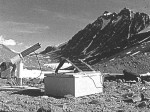The LTER/NASA atmospheric correction project is proceeding in its second year with funding from the Terrestrial Ecology Division within Mission to Planet Earth of NASA. The primary goal is to develop an operational method to correct satellite data for artifacts introduced by the presence of aerosols and water vapor in the atmosphere.
These atmospheric constituents act as a sort of cataract for remote sensing data, reducing their clarity, as well as their comparability. The corrected datasets are produced by modeling constituents of the atmosphere and reconstructing the remote sensing data to wavelength specific reflectance values.
Landsat Thematic Mapper satellite data is being used as an initial dataset for the corrections, with 18 images corrected for the H. I. Andrews (AND), Bonanza Creek (BNZ), Harvard Forest (HPR), North Temperate Lakes (NTL), Sevilleta (SEV) and Virginia Coast Reserve (VCR) LTER sites.
Corrections of NOAA Advance Very High Resolution Radiometer data for the Taylor Dry Valley/McMurdo (MCM) and other datasets are also underway. A second workshop for the project was held August 16-18 at facilities of the LTER Network Oftice at the University of Washington. The workshop included discussions of the current status and future plans for the project by the 17 LTER and NASA researchers at this meeting.
Further information on this project can be found through the LTER Internet home page or directly at the project home page at http://www.lternet.edu/nasa/atrncor.
John R. Vande Castle, LTER Network OECE, University of Washington

 Enlarge this image
Enlarge this image